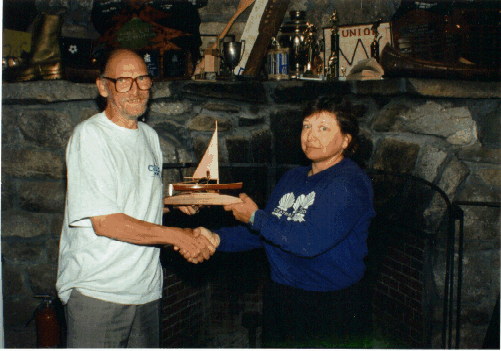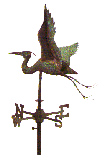Their motto is "Sail when you can, paddle when you must!"
International Racing
From the Gossip of the Open Canoe Sailing Group, # 90 Sept. 19997, by John Bull, England .
We hear, via the ACA Canoe Sailor, that the Americans are thinking of a challenge for the International Trophy in 1999. As yet of course we have no agreed on class rules and how this can be resolved is by no means clear.
There are a number of questions, of ascending difficulty, we need to consider and find answers to.
- Do we want an international class at all?
- Do we want to muddle along as we are, sailing each others' boats to each
others rules when we visit. OK for us but it leaves new countries without a
"standard" to adopt. The longer this state of affairs exists the harder agreement
between several or even many countries becomes.
- One or other, the UK or the US adopts the others class rules. The difficulties
are obvious, we both have a considerable investment, in several respects, in
what we have and the cost of a change would fall entirely on one country.
- The introduction of an entirely new class at some future date.
We need to bear in mind that it is not likely that transporting boats will ever be a practical proposition but transporting the rest of the rig is. This would go some considerable way to bringing your performance with you.
If we have ambition to see organised canoe sailing spreading in Europe and elsewhere this is a nettle we need to grasp soon. If the two of us, the UK and the US cannot come to an agreement it is unlikely that seven or eight of us at some future date will.
John Bull and Marilyn Vogel with the International Trophy provided by John
Bull in 1995.

International Standards? By Marilyn Vogel, USA
We have tried international racing in open sailing canoes for two years now with mixed results. With a larger pool of competitors and hulls, the host has been winning. We are tied one to one. The real advantage has been that sailors on both sides of the Atlantic have had a new awareness and rewarding experiences. It was challenging and fun! It promotes growth of canoe sailing sport and new design ideas. International open canoe sailing is so respectable!
There have been differences as well as similarities. In the Gossip newsletter, the British sailors have been concerned with establishing useful rules. At the last Annual National Canoe Sailing Meeting in the US, we discussed the status of having an international rig, the ACA rig. Our ACA rules have been formulated over a century and we favor their international adoption. We realize that any rules will exclude some sailors but the ACA Class is our least restrictive. We all agree that we do not want to pay to transport boats across the ocean and that we do not want another rig to use once every three years.
While it appears that sailors are equally competitive, the vast differences in rigs and rules leaves many surprises for visiting competitors. When the British raced with us in Maine they were surprised at how many rules we sailed by and our specialized rigs. When we sailed in England we were surprised at the lack of rules and how many different types of rigs they used! Historically, only the Americans have maintained open canoe sail racing since 1870, whereas this event in other countries is relatively new. With only the Americans, British and Northern Irish competing so far, we are miles apart on standards for International Racing.
Simon Fishwick, Gossip, No. 71, December 1996, said that one reason for having rules is "to ensure that all the boats have a similar level of performance, so that sailing skills play a major role in determining race results..." Differences among rigs and rules so far prohibit a similar level of performance. Hulls, symmetrical or not, are dissimilar in design, size, weight and materials. Sail measuring currently results in a 1.5 or two square foot disparity: the British use the International Yacht Racing Union system; the Americans use the International Canoe Federation system. We cannot agree on using leeboards, standard in the U. S. In Britain some sailors use bilgeboards which enter the sides of the hull. Use of a paddle: in the US a sailor may not use a paddle for propulsion; for turning into the wind it is acceptable to do a reverse stroke but never a forward stroke. In Britain, the OSC Group allows sailors to use a forward stroke to turn into the wind.
In international competition where the foreigner is at the mercy of the host to provide equipment, extra planning is required. For example, use of only one hull in a race series is necessary. Thus, should you be able to change sails unless everyone can? International standards for racing rules and rigs is so far from practice that it can only be a long range goal. We should develop goals first, but still leave room for individuality.
Proposal
- Use the International Canoe Federation (ICF ) rules which governs canoe
racing, including the International Decked Sailing World Championships. This
affects our sail measuring system. All other international canoe racing falls
under the ICF.
- Have 5 or 10 year goals in order to narrow the differences in dissimilar
hulls, rigs, and rules.
Perhaps small changes over the years could accomplish some common good. We do not need exactly the same hulls and rigs, just some international standards. People who are replacing equipment or entering the sport could be advised. of general guidelines.
Other goals would be to:
- Promote individual visits to other countries for scheduled canoe sailing get-togethers.
- Have International get-togethers every three or four years, like the IC World Championships.
- Encourage competitors from more countries.
- Have international competition that is inclusive not exclusive in order to foster growth of the sport. (Inclusive competition would be to include beginners and experienced sailors at the same event.)
- Have a variety of competitions which are fun and lead to skill development and teamwork. Three examples are (1) The International Team Relay Race, (2) paddle and sail combination race, and (3) team racing in a capsize and rescue race, or picking up a bottle.
- Continue the Race Series for the International Trophy for 5 races spread over three days and include a practice race for the first race.
Also, visit the Open Canoe Sailing Group of Great Britain website.

Windermere, England, 1996
 Main Page |